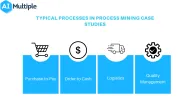We explore key statistics that highlight the growing influence of low code/no code solutions across industries, shedding light on their impact, adoption rates, and potential for shaping the future of technology.
Low-code market forecast
- The global low-code development platform market is predicted to generate a revenue of $187 billion by 2030, rising from $10 billion in 2019, and is expected to advance at a fast pace, 31% CAGR, during the forecast period. (GlobeNewswire)
- 75% of large enterprises will be using at least four low-code development tools for both IT application development and citizen development initiatives. (Gartner)
Market Adoption
- 70% of new applications developed by organizations will use low-code or no-code technologies by 2025, up from less than 25% in 2020. (Gartner)
- 41% of businesses have active citizen development initiatives and 20% of those who don’t are either evaluating or planning to start citizen development initiatives (Gartner)
- About 79% of businesses build a web application with citizen development within a year. (Gartner)
- Half of all new low-code customers will come from business buyers outside the IT organization by the end of 2025. (Gartner)
- Nearly 60% of all custom apps are now built outside the IT department. Of those, 30% are built by employees with either limited or no technical development skills. (451 Research)
Why does low code matter?
Low-code app development
- IT is the second-largest area for businesses to address potential skill gaps after data science. (McKinsey)
- The average software developer salary in 2020 was more than $100K a year in the US. Though no-code solutions don’t fully replace a developer functionally, they help developers focus on more difficult projects and they cost significantly less than hiring a new developer. (U.S. News)
- 82% of firms say custom app development outside of IT is important. (451 Research)
Low-code AI development
- 40% of companies state AI technologies and expertise are too expensive. (Deloitte)
- The average data science salary is $101k. (U.S. Bureau of Labor Statistics)
- 83% of businesses say AI is a strategic priority for their businesses today yet, there is not enough data science talent. (Forbes)
- As of 2020, there are three times more data science job postings than job searches. This promotes businesses to invest in citizen data scientist practices for AI development. (Quanthub)
Benefits of low-code
- Low-code/ no-code solutions have the potential to reduce the development time by 90%. (Redhat)
- The average company avoided hiring two IT developers using low code tools. This reaped about $4.4 million in increased business value over three years from the applications designed. (Forrester)
Low-code development use cases
- According to a survey by Gartner, top low-code development use cases are
- forms or data-collection apps (58%)
- apps that orchestrate business processes and workflows within apps (49%).
- apps that replace paper, email, or spreadsheets (42%)
- customizing new app UI for current on-premise applications (22%) (Gartner)
- The average number of apps developed by citizen developers is 13 and web apps are the most common type of citizen development. (Gartner)
- In 2021, 33% of respondents from a global survey by Statista indicated that their organization is using low-code for data modeling and visualization. (Statista)
Case studies
- Schneider Electric launched 60 apps in 20 months, with most delivered in 10 weeks. (Bloomberg)
- Ricoh replaced legacy systems with a low code platform which helped them achieve a 253% ROI and a payback in just 7 months. (Bloomberg)
- thinkmoney delivered a modern mobile digital banking experience in just 14 weeks. (Bloomberg)
Facts about the low-code industry
- We have identified 223 low-code platforms for development and 13 low code platforms for developing machine learning solutions.
- 42 vendors of low-code development tools primarily structured as PaaS (platform as a service). (Forrester)
- “Ease of use” is the most used (20%) positive word describing low-code / no-code development platforms based on data collected from customer reviews for all low code / no-code development platforms companies. (AIMultiple)
- The most negative describing low code solution is” clunky” with being used in 5% of all low code / no code development platforms the reviews. (AIMultiple)
Funding raised by low-code application development vendors
Low-code application development tools are used to develop applications without relying on code. These applications are used by human end users to complete forms or other process steps
Low code automation tools are used to automate tasks. They may or may not be used directly by human users, for example, some automation (i.e. unattended automation) work in the background.
Here we focus on low code application development tools:
- OutSystems has raised a total of $422.1M in funding over 5 rounds. (Crunchbase)
- Mendix has raised a total of $38M in funding over 3 rounds. (Crunchbase)
- ServiceNow has raised a total of $83.7M in funding over 6 rounds. (Crunchbase)
- Appian has raised a total of $47.5M in funding over 2 rounds. (Crunchbase)
If you are looking for a low code/ no code/ codeless vendor, feel free to check our vendor lists where sorting vendors by AIMultiple score shows the best solutions based on maturity, popularity, and satisfaction:


Comments
Your email address will not be published. All fields are required.